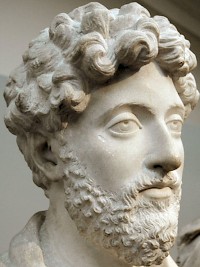Legio II Italica
Legio II Italica Pia: one of the Roman legions. Its name means "the faithful Italian legion", although it may also mean "the Italian legion of Pius" - a reference to the late emperor Antoninus Pius.

Together with III Italica, this unit was founded in 165 or 166 by the emperor Marcus Aurelius, who needed extra soldiers in his war against the Germanic Marcomanni (Cassius Dio, Roman Histories, 55.24.4). At that time, Marcus' brother and co-emperor Lucius Verus was fighting a war against the Parthian Empire. To indicate that the legion was founded by both men, its emblem was the she-wolf with the legendary twins Romulus and Remus. (In fact, a rather ironical choice, because Romulus killed his brother.)
The first recruits came from Italy and Noricum, one of the provinces on the Danube threatened by the Marcomanni. It is not known where the legion was first stationed, but in 171, the presence of the Second Italian legion in Noricum is secured. It is likely that the legion was, together with I Adiutrix and III Italica, part of a task force commanded by Publius Helvius Pertinax, the future emperor. This army group had to secure the provinces Raetia and Noricum. At the same time, soldiers of II and III Italica were constructing the town walls of Salona (modern Split).
During the Marcomannic wars, the legion stayed at several places near the Danube, but after 180, it found a permanent base at Lauriacum (Lorch) at the confluence of the Enns and Danube. In 205, this base was rebuilt, and it was to be in use until the end of the Roman presence in Noricum.
On 1 January 193, Pertinax became emperor, but he was killed after a very brief reign and a rich senator, Didius Julianus, became emperor. Immediately, the governor of Pannonia Superior, Lucius Septimius Severus, marched on Rome, where was recognized as emperor. II Italica was among his troops, and may have played a role in securing Noricum. It was rewarded the title Fidelis ("loyal"). Later, subunits of the legion were employed during Severus' campaigns against his rivals Pescennius Niger and Clodius Albinus, and perhaps during his Parthian wars.
In the third century, II Italica took part in Maximinus' wars in Dacia and in at least one campaign against the Visigoths. During the conflict between the emperor Gallienus and his rival Postumus, the legion supported the first-mentioned, for which it was rewarded with surnames like Pia V Fidelis V ("five times faithful and loyal"), Pia VI Fidelis VI, and finally Pia VII Fidelis VII.

The legion was still at Lorch in Noricum in the age of the emperor Diocletian, who created I Noricorum to assist II Italica. A generation later, a subunit was transferred to Divitia (Deutz), a castle on the lower Rhine near Cologne. This subunit became an independent legion, II Italica Divitensium, and played a very important role during the march on Rome of Constantine I the Great and in the famous the battle near the Milvian bridge (312). In the fourth century, this twin-legion of II Italica belonged to the mobile field army.
Meanwhile, the Second Italian legion and I Noricorum still guarded the Danube at Lorch. II Italica Pia Fidelis is still attested at the beginning of the fifth century.
Related
- B. Lörincz, "Legio II Italica", in: Yann Le Bohec, Les légions de Rome sous le Haut-Empire (2000 Lyon) 145-149
- article by Emil Ritterling.